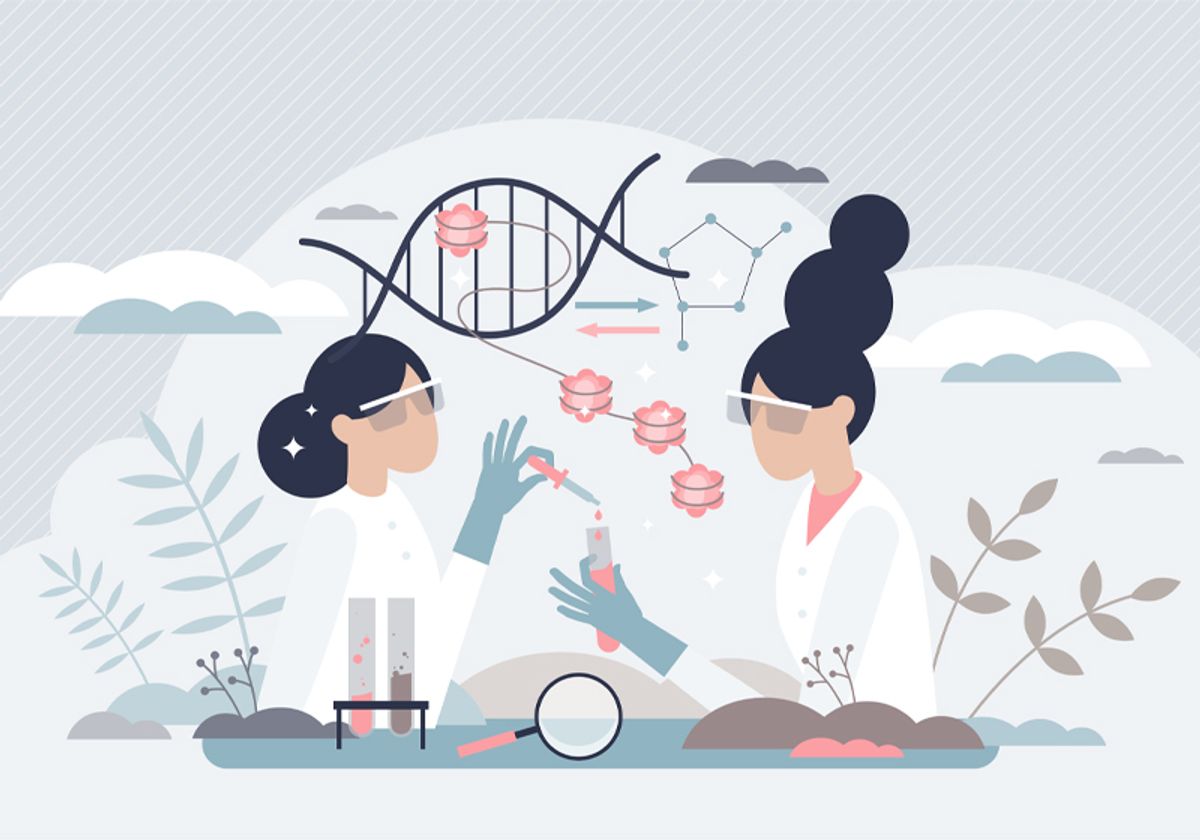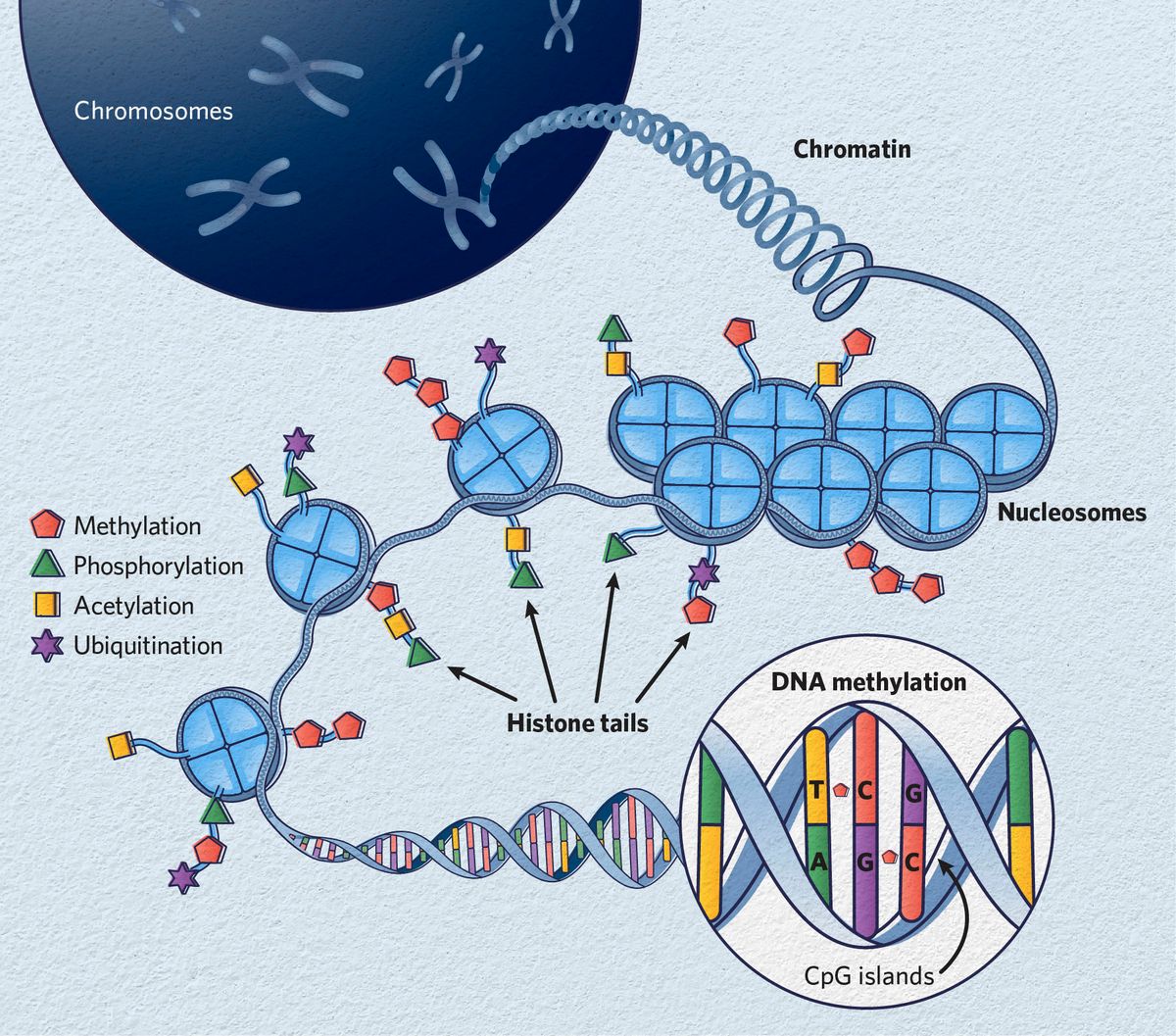This article was reviewed by Brian Cosgrove, PhD from Tune Therapeutics.
Stay up to date on the latest science with Brush Up Summaries.

Since its discovery in the early 1940s, epigenetics has been established as a key driver of human development, health, aging, and disease, and is now a burgeoning field of research. In this article, we discover how the epigenome can affect phenotype without changing the underlying DNA sequence, the different types of epigenetic modifications, how epigenetic marks are inherited, its effects on aging and disease, and how the epigenome can be modified for therapeutic benefit.
What Is Epigenetics?
Epigenetics is the study of various heritable alterations that control gene expression without changing the DNA sequence.1 The name epigenetics comes from the Greek prefix “epi”, which means on top of, or in addition to, genetics.2 The collection of epigenetic marks in a cell or organism is known as its epigenome.
“Epigenetics is the layer of control that sits on top of the DNA sequence itself, and it's what dictates if genes turn on or not,” explained bioengineer Brian Cosgrove, who works as a principal scientist at the epigenome editing startup Tune Therapeutics. “Another way to think about it is that the genes are like the Lego building blocks, and epigenetics is like the set of instructions that tell you what to make with those building blocks.”
By controlling gene expression, the epigenome is largely responsible for regulating cellular differentiation and the specialized phenotype and function of cells.3 Many epigenetic modifications are crucial for human development, for example during the formation of germ cells and early in embryogenesis.4 However, environmental influences, lifestyle factors, and the simple passage of time can affect and dysregulate the epigenome, potentially causing disease.1
Epigenetic Changes
There are several different types of heritable epigenetic marks or modifications, the most established and well-researched of which are histone modifications and DNA methylation. “What's exciting about the field is that our knowledge of what actually regulates the epigenome is expanding. What started as a very small, narrow list is increasing more and more as we learn about all the different control knobs in the cell that sit on top of that DNA,” Cosgrove commented.

Histone modifications
Histone modifications affect the overall structure of chromatin, a nucleoprotein complex in which short sections of DNA wrap around four core histone proteins to form nucleosomes, which are joined together by small regions of linker DNA.5 The N-terminal tails of histone proteins, which protrude from the nucleosome, can undergo several different types of posttranslational modifications.1 These include, but are not limited to, acetylation, methylation, phosphorylation, and ubiquitination.6
One function of histone modifications is to make DNA more or less accessible for transcription. Heterochromatin is highly condensed, creating transcriptionally inaccessible regions of the genome, while euchromatin is less condensed and packages regions that are much more accessible to transcription machinery.7
“There's chromatin looping, which is the idea that you can have [DNA] folding in three-dimensional space. [This refers to] gene regulation that's dictated by very long-range contacts of something that is, by genomic distance, very far away, but by spatial distance, right on top of each other. So, this whole idea of chromatin packing and chromatin folding comes into play, of where are the genes in the cell, and how are they regulated that way,” remarked Cosgrove.
DNA methylation
DNA methylation is the addition of a methyl group to the 5' position of a cytosine in a cytosine-guanine (CpG) dinucleotide.7 These CpG sites (where “p” refers to the linking phosphate between the nucleotides) often occur in clusters known as CpG islands, which are common in the promoter regions of genes.8
CpG methylation is catalyzed by DNA methyltransferases (DNMTs), a conserved family of cytosine methylase enzymes.9 The result is 5-methylcytosine (5mC), a repressive epigenetic mark associated with stable gene silencing controlled by methylated promoters.8
“Generally, methylation at the promoters of genes is associated with a packed down, turned off promoter, and a lack of methylation is generally associated with something that's accessible and ready to transcribe,” said Cosgrove.
Epigenetic Inheritance
Like the genome, the epigenome is heritable. Once established, some epigenetic information is maintained during cell division, contributing to stable lineages of differentiated cells.3
Some epigenetic marks can also be passed from parents to offspring through the germline, a recently established phenomenon known as transgenerational epigenetic inheritance.10 An offspring’s epigenome can also be affected by exposure to specific conditions in utero, influencing the offspring’s germline and therefore affecting subsequent generations through intergenerational inheritance.10
Epigenome Sequencing
Scientists use a variety of next-generation sequencing methods to measure and map the marks that make up the epigenome. Bisulfite sequencing has previously been the gold standard of DNA methylation sequencing, but the harsh chemical reaction causes DNA damage. This led to the development of newer bisulfite-free methods such as enzymatic methyl-sequencing (EM-Seq) and TET-assisted pyridine borane sequencing (TAPS).11
To sequence histone modifications, many researchers are now turning towards cleavage under targets and release using nuclease (CUT&RUN) or cleavage under targets and tagmentation (CUT&Tag) methods. These more efficient approaches can replace older technologies such as chromatin immunoprecipitation sequencing (ChIP-seq), which is significantly more labor-intensive, has a higher rate of false positives, and requires much larger cell input.11 “The idea is that you chemically fix the cells to freeze everything in place, you dice the DNA all up into pieces, and then you take an antibody for [histone 3 lysine 27 trimethylation] or some other kind of protein feature, and then you enrich only the pieces of DNA that have that protein [attached],” said Cosgrove.
The recent development of assay for transposase-accessible chromatin with sequencing (ATAC-seq), a simple sequencing method using only a small number of cells as input, has allowed researchers to determine chromatin accessibility throughout the genome.12 In contrast, researchers can use new methods such as Micro Capture-C (Micro-C or MCC) or Hi-C to study chromatin interactions. “Those enable people to [explore] where have things looped spatially and where…distant regions of DNA are touching,” Cosgrove added.
Epigenetics in Human Health and Therapeutics
Epigenetic dysregulation is a key driver of a wide variety of diseases. “Nearly every process in the body, in some form or other, is epigenetically regulated,” explained Cosgrove. Scientists seek epigenetic disease treatments that can alter or remove epigenetic marks via drugs or epigenome editing, a derivative of CRISPR-Cas9 gene editing technology.13
Cancer epigenetics
Dysregulation of the epigenome, specifically DNA methylation, is now a well-established hallmark of cancer and is involved in tumorigenesis.11 Methylated DNA from tumors is commonly found in the blood of cancer patients as cell-free DNA (cfDNA), making it useful for non-invasive cancer testing known as liquid biopsy. Because the cfDNA from tumors retains the epigenetic profile of its tissue of origin, clinicians can use it to identify the location of the tumor.14 Several drugs exist that act as epigenetic modifiers in the treatment of cancer; however, they have significant drawbacks.
“There are these clinically approved drugs that can work and be tolerable enough in certain circumstances, but they're very pleiotropic. It's very hard to turn off all these things and many things will change in response,” said Cosgrove.
Epigenetic aging
Epigenetic alterations, such as DNA methylation, are primary drivers of aging in humans, and longevity researchers can use the buildup of these alterations over time as biological or epigenetic clocks.15 According to Cosgrove, epigenome editing to reverse the biological age of cells and tissues is an emerging and controversial concept. “You can imagine, what if you could take an older cell and you reprogram it to be a younger cell, just by changing the epigenetic state and the [chromatin] accessibility?” said Cosgrove.
Multifactorial diseases
In his work at Tune Therapeutics, Cosgrove uses epigenome editing technology to target complex diseases, in which the expression of several different genes must be tuned to normal levels.16 “In a lot of epigenetic diseases…like heart disease, there are multiple genes implicated. It's not like an on- or off-switch, it’s not necessarily driven by a point mutation. It's driven by [gene expression] that should be set at five, being set to 11,” he explained.
Editor’s note: Brian Cosgrove is an employee of and holds stock options in Tune Therapeutics.
- Handy DE, et al. Epigenetic modifications. Circulation. 2011;123(19):2145-2156.
- Kanherkar RR, et al. Epigenetics across the human lifespan. Front Cell Dev Biol. 2014;2.
- Gibney ER, Nolan CM. Epigenetics and gene expression. Heredity (Edinb). 2010;105(1):4-13.
- Dupont C. et al. Epigenetics: Definition, mechanisms and clinical perspective. Semin Reprod Med. 2009;27(05):351-357.
- Quina AS, et al. Chromatin structure and epigenetics. Biochem Pharmacol. 2006;72(11):1563-1569.
- Bannister AJ, Kouzarides T. Regulation of chromatin by histone modifications. Cell Res. 2011;21(3):381-395.
- Alberts B, et al. Molecular Biology of the Cell. 5th ed. (Anderson M, Granum S, eds.). Garland Science; 2008.
- Angeloni A, Bogdanovic O. Sequence determinants, function, and evolution of CpG islands. Biochem Soc Trans. 2021;49(3):1109-1119.
- Lyko F. The DNA methyltransferase family: a versatile toolkit for epigenetic regulation. Nat Rev Genet. 2018;19(2):81-92.
- Horsthemke B. A critical view on transgenerational epigenetic inheritance in humans. Nat Commun. 2018;9(1):2973.
- Chen X, et al. Mapping epigenetic modifications by sequencing technologies. Cell Death Differ. Published online 2023.
- Grandi FC, et al. Chromatin accessibility profiling by ATAC-seq. Nat Protoc. 2022;17(6):1518-1552.
- Nakamura M, et al. CRISPR technologies for precise epigenome editing. Nat Cell Biol. 2021;23(1):11-22.
- Moss J, et al. Comprehensive human cell-type methylation atlas reveals origins of circulating cell-free DNA in health and disease. Nat Commun. 2018;9(1):5068.
- Pereira B, et al. Epigenetic reprogramming as a key to reverse ageing and increase longevity. Ageing Res Rev. 2024;95:102204.
- McCutcheon SR, et al. Epigenome editing technologies for discovery and medicine. Nat Biotechnol. 2024;42(8):1199-1217.



